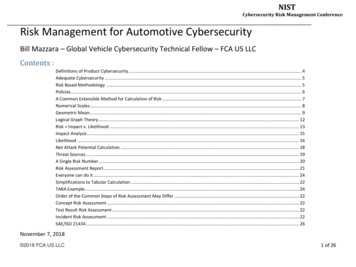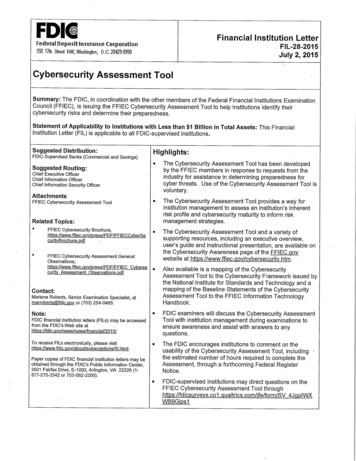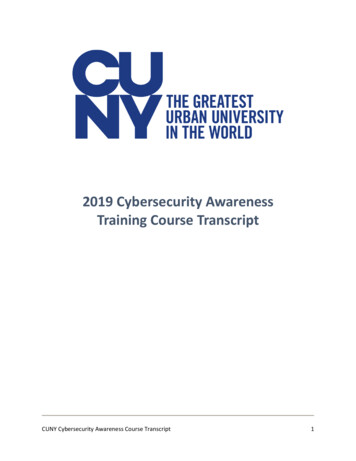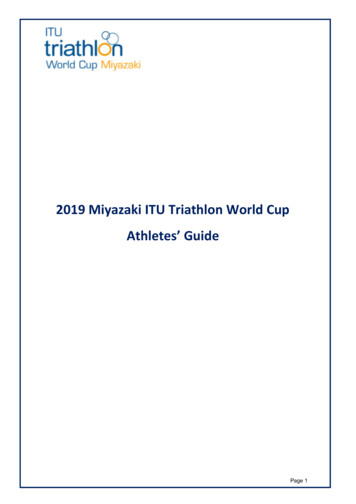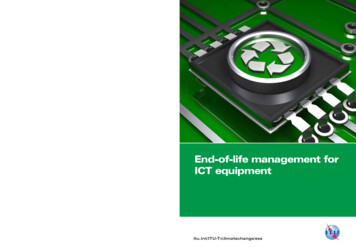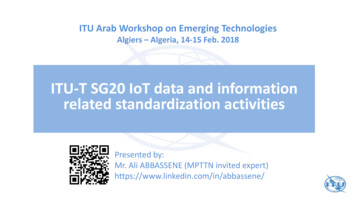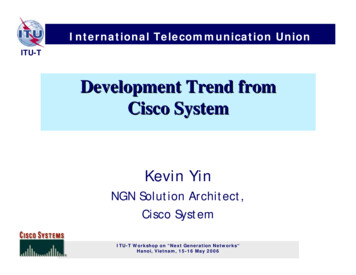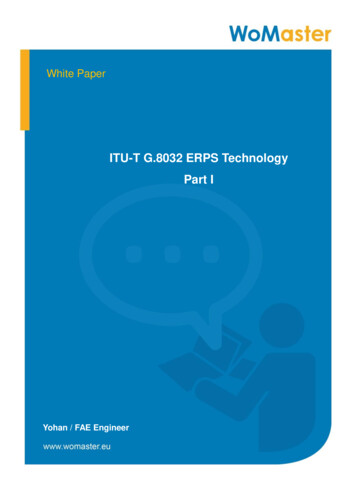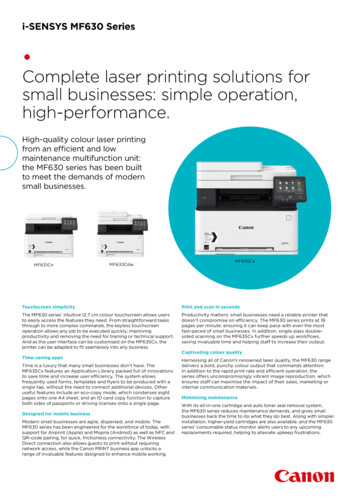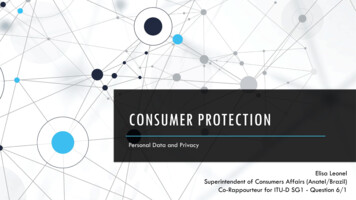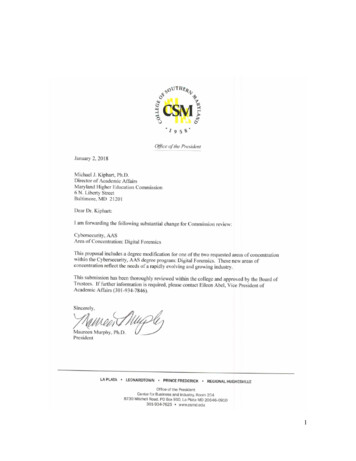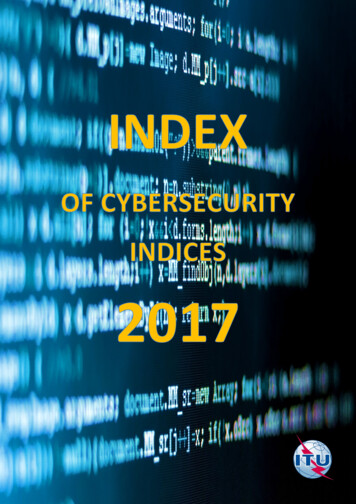
Transcription
cybersecurity@itu.int
5.3T ABLE OF CONTENTSINDEX OF CYBERSECURITY INDICES 2017 . 3Definitions . 3INDICES FOR ASSESSING COUNTRIES . 6Cyber Maturity in the Asia-Pacific Region . 6National Cyber Security Index . 7Global Cybersecurity Index . 8Kaspersky Cybersecurity Index . 9Asia-Pacific Cybersecurity Dashboard . 10Cyber Readiness Index 2.0 (CRI 2.0) . 11Cyber Power Index . 12The CyberGreen Index . 13INDICES FOR ASSESSING ORGANIZATIONS . 14The Accenture Security Index. 14Cybersecurity Poverty Index . 15Global Cybersecurity Assurance report cards . 15Cybersecurity Capability Maturity Model . 16INDICES FOR ASSESSING OTHER ASPECTS. 16IBM X-Force Threat Intelligence Index 2017 . 16Index of Cybersecurity . 16Cybersecurity Index . 17cybersecurity@itu.int
2INDEX OF CYBERSECURITY INDICES 2017The increase of recent incidents and breaches of cybersecurity demonstrates the challenge all usersof the Internet (governments, organizations and citizens alike) face to keep up with the speed of ICTevolution. To embrace this technology progress, cybersecurity must form an integral and indivisiblepart of the process. Therefore, various factors must be taken into consideration, as the applicationof cybersecurity is a continuous process that needs to match ongoing cybercriminal activities andthreat campaigns.As such, in 2015 and in collaboration with ABI Research, ITU compiled and published some of theoutstanding cybersecurity indices. As cybersecurity issues continue to compound with time, newindices regarding cybersecurity challenges need to be established. This year, ITU has identified newindices and updated the previous Index of Cybersecurity Indices of 2015. The index of indicespresented below is not an exhaustive list. It is a presentation of existing surveys, indices andpublications from private and public organizations. These indexes can be broadly split into threemajor groups: indices for assessing countries’ national postures, indices for assessing organizations,and indices for assessing threats. The three groups are presented below alongside current relevantindices.2.1D EFINITIONSThe table below proposes a snapshot of the content and the methods used by the various indexesexamined. This content is briefly detailed in the following pages. A short explanation of eachindicator’s meaning is presented at the end of this section.Scores: The score is based on an individual result using the total score of all indicators. This type ofscale allows participants to have a view on their individual status regarding the different capabilitiesmeasured. The indices examined use different rating methods - percentages, ratios etc.Ranking: Each participant is ranked compared to the others. The ranking scale allows participantsto be aware of their level in relation to the other participants.Information Society Development: Is a society where the creation, distribution, use, integrationand manipulation of information is a significant economic, political, and cultural activity. The peoplewho have the means to partake in this form of society are sometimes called digital citizens.Cyber Maturity: An assessment providing an in-depth review of an organization’s ability to protectits information as well as its efforts and readiness against cyber threats.Cyber Threats: The potential of a malicious attempt to damage or disrupt a computer network orsystem with unauthorized access to a control system device using a data communications pathway.Threats to control systems can come from numerous sources, including hostile governments,terrorist groups, disgruntled employees, and malicious intruders.Cyber Vulnerabilities: Is a weakness which reduces a system's security assurance. Vulnerability is asystem susceptibility or flaw that is accessible to an attacker or not otherwise mitigated by acountermeasure.Organizational: The measurement of policy coordination institutions and strategies forcybersecurity development within countries and companies in order to secure the organization’ssmooth running and longevity while reducing cyber-attacks.cybersecurity@itu.int
Technical: The measurement of technical institutions, terms, or frameworks dealing withcybersecurity. In this aspect, some indices check the commitment of countries/organizations ontheir available technical measures while others provide a technical guide on software to enhancesecurity.Economical: This notion represents the presence of an economic impact, cost or managementmeasurement in the index while others present it as a business alignment and investment efficiencyof an organization in accordance to cybersecurity.Legal Framework: The measurement of legal institutions and frameworks dealing with cybersecurityand cybercrime. It also involves rules, legal trainings, standardizations and regulations related tocybersecurity.Cooperation: The existence of partnerships, cooperative frameworks and information sharingnetworks between countries and organizations.Capacity Building: The existence of research and development, good practices, education andtraining programmes; intended to enforce better understanding, approach and awareness towardscybersecurity.Recommendations: A recommendation is a proposal or list of suggestions normally provided bycompetent bodies or authorities. An index may provide recommendations on what measures orsteps ought to be taken to better the cybersecurity of the countries/organizations studied.Profiles: The index presents a short description of the activities undertaken by the differentorganizations and countries examined.Website: The survey has an official Website where the majority of the information regarding theindex can be found.PDF: The survey proposes a Portable Document Format (PDF) with survey’s detailed report andoutputs.Visualization: The representation of information through graphical references, images, scorecards,interactive images, heat maps, videos or others.cybersecurity@itu.int
xxKaspersky Cybersecurity IndexxAsia-Pacific CybersecurityDashboardxxxxxCybersecurity Poverty IndexxCyberGreen IndexxxxThe Accenture Security IndexxxxGlobal CybersecurityAssurance Report CardsxxxxxxxxxxxxxxxCybersecurity CapabilityMaturity ModelxxxxxxNo. of xxxxxxCapacity BuidingxxxIndex of CybersecurityxTechnicalOrganizationalxxxIBM X-force Threat IntelligenceIndexxxCyber Readiness Index 2.0Cyber Power IndexCyber VulnerabilitiesCyber ThreatsCyber MaturityxxPDFGlobal Cybersecurity IndexxxWebsitexxProfilesxCooperationNational Cyber Security IndexxLegal FrameworkxPresentationFormatEconomicalCyber Maturity in the AsiaPacific RegionContentInformation SocietyDevelopment Score(ISD) t13
3INDICES FOR ASSESSING COUNTRIESIndices for assessing countries have been developed by international organizationsand think tanks, often in partnership with private sector organizations. At the highestlevel, these indices look at, among others, policy and regulatory aspects,organizational measures, national strategies, and cooperative efforts. Some indicessimply compare and contrast measures amongst countries, while others provide anindex scoring based on indicators. Others provide rankings based on the scoring. Alloffer valuable information on cybersecurity practices and gaps at the nation statelevel.3.1C YBER M ATURITYIN THEA SIA -P ACIFIC R EGION 1Number of countries:23Research Method:Secondary dataRank or Score:ScoresIndicators:11Developer:The Australian StrategicPolicy InstituteThis index, developed by the Australian Strategic Policy Institute, is the third editionof an annual report providing information on Asia and the Pacific nation state’s levelsof cyber maturity.A total of 23 countries in the Asia and the Pacific region have been analyzed; with theUS being used as the reference point for overall cyber maturity. The index is focusedon government policies and legislative structures of cybersecurity. The methodologyuses a cyber maturity metric to assess the various facets of nations’ cyber capabilities.A set of 11 indicators has been produced and each state’s level of cyber maturity hasbeen measured against the benchmark provided with each indicator. The scores arebased on data provided by the International Telecommunication Union (ITU). Thepublication includes an overall ranking of cyber maturity for each state within theregion, as well as an individual score and short profile. A color reference base allowsfor quick assessment. The publication is classified as an index since it has indicators,scoring and ranking mechanisms. The color-coded reference base is a neat addition.The individual country profiles are helpful and provide a snapshot of nationalactivities. The focus is primarily on organizational structures, legislation, internationalcooperation, CERTs and military capabilities. However, it is only a regional index aturity-2016cybersecurity@itu.int
on open source and publicly available information, and could benefit from a surveybased data collection exercise3.2N ATIONAL C YBER S ECURITY I NDEX 2Number of countries:25Research Method:Primary & SecondaryRank or Score:Rank & ScoreIndicators:12Developer:Estonian e-GovernanceAcademy & EstonianForeign MinistryThis is the first version of an index developed by the Estonian e-Governance Academyin cooperation with the Estonian Foreign Ministry. The index is focused on the publicaspects of national cybersecurity, which are implemented by the central government.The aim of the index is to measure the cybersecurity level of countries, especially theirpreparedness to prevent cyber threats and their readiness to manage cyber incidents,crime and crises on a large scale.A total of 25 countries have been analyzed with data collected using both primary andsecondary research. The index has 12 main indicators, which are divided into fourgroups: General Cyber Security Indicators, Baseline Cyber Security Indicators, Incidentand Crisis Management Indicators and International Incident Indicators. These 12indicators have sub-indicators and aspects that can be measured in points (0 to 100).The indicators have been tied to cybersecurity and information society as e-identity,digital signature and the existence of a secure environment for e-services. The indexhas a score and ranking mechanism.The advantage of this index is that it has an online global database and it shows whatcountries can do to improve their cybersecurity. It also gives an overview of thepreparedness of countries to prevent cyberattacks and crimes as well as how tomanage them. The goal is to have a global reach by the end of bersecurity@itu.int
3.3G LOBAL C YBERSECURITY I NDEX 3Number of countries:194Research Method:Primary and SecondaryRank or Score:Rank and nicationUnionAn index developed by the International Telecommunication Union (ITU), which aimsto provide insight into the cybersecurity engagement of sovereign nation states.Rooted in the ITU’s Global Cybersecurity Agenda (GCA), the GCI looks at the level ofcommitment in five areas: legal measures, technical measures, organizationalmeasures, capacity building, and cooperation. The result is a country-level index andglobal ranking of cybersecurity commitment. A total of 194 countries have beenanalyzed, 135 of which have been subjected to both primary and secondary researchand only 59 a subject of secondary research. The publication includes an overallranking, as well as six regional rankings and an individual score for each country. The2017 publication is the second report produced and there will continue to be furtherupdated iterations.The publication is classified as an index since it has indicators, scoring and a rankingmechanism. The main advantage of this publication is its global character (the onlypublication with such a broad geographical range). It is based on both a survey amongITU Member States and open sourced material. It is also worth noting the publicationfocuses on five broad cybersecurity application areas, which include 25 indicators andis further refined with additional ecurity/Pages/GCI-2017.aspxcybersecurity@itu.int
3.4K ASPERSKY C YBERSECURITY I NDEX 4Number of countries:21Research Method:PrimaryRank or Score:ScoreIndicators:3Developer:Kaspersky Lab &B2B InternationalAn index developed by Kaspersky Lab in cooperation with B2B International. Its focusis to evaluate, through a multi-dimensional concept, the level of risk internet usersare exposed to on a daily basis in cyber space. The Kaspersky Cybersecurity Index is asurvey that occurs twice a year. 21 countries across the globe have been analyzed anda total of 17,377 respondents participated in the survey in the second half of 2016.The sample includes thousands of adult Internet users around the world classified byage and gender. The index has three key indicators, namely: “Unconcerned” (theproportion of people not believing that they could be a target for cybercrime),“Unprotected” (the number of users who fail to protect themselves from cyberthreats with the help of antivirus or Internet security software across all theirdesktops, laptops and mobile devices) and the “Affected” (the people who haveexperienced different cybersecurity incidents during the previous months). Theseindicators provide information needed to monitor the degree of risk to the averageinternet user. The selected countries are scored by percentage in each of thecategories.To evaluate the online environment for internet users, some additional statistics arepresented in a variety of graphs such as users’ online behavior, their concerns, whatissues they face and how they defend themselves against possible ses/2016 rity-index4cybersecurity@itu.int
3.5A SIA -P ACIFIC C YBERSECURITY D ASHBOARD 5Number of countries:10Research Method:SecondaryRank or Score:NoneIndicators:31Developer:BSA, Software AllianceThe Dashboard is a publication developed by BSA The Software Alliance. Thepublication is focused on policy and organizational aspects of cybersecurity, withstrong reference to legal foundations as well as cooperation between public andprivate sector. The aim of this cybersecurity dashboard is to provide a reference basewhich allows the evolution of countries’ cybersecurity policies by comparing themwith the other Asia and the Pacific countries.This publication was developed based on publicly available information with notargeted interviews conducted and covers ten countries from the Asia and the Pacificregion.The methodology of the publication is based on 31 indicators including: legalfoundations, operational entities, public private partnerships, sector-specificcybersecurity plans, education and additional cyber law indicators. Each indicator isgiven one of four statuses: Yes, No, Partial and N/A. The publication does not offerscoring or ranking mechanisms.What is interesting about this publication is a graphical reference base, which allowsfor a quick evaluation of countries’ cybersecurity stance. The individual countryprofiles are helpful and provide a snapshot of national activities. The focus is primarilyon policy, legal and organizational aspects of cybersecurity with strong reference topublic private partnerships. However, it is limited in geographic range to Asia and thePacific and could strongly benefit from a survey based data collection ssets/PDFs/study apac cybersecurity en.pdfcybersecurity@itu.int
3.6C YBER R EADINESS I N DEX 2.0 (CRI 2.0) 6Number of countries:125Research Method:Primary & secondaryRank or Score:ScoreIndicators:7Developer:Potomac Institute forPolicy StudiesThe CRI 2.0 is developed by the Potomac Institute for Policy Studies. The publicationevaluates nation state’s cyber maturity as well as their overall commitment to cyberissues. The aim of the publication is also to define the meaning of being “cyber ready”while proposing actionable blueprints to follow. The publication is mainly focused onpolicy and economic aspects of cybersecurity and includes fact-based assessments ofcountries’ cyber readiness. 125 countries were studied. Individual country profilesare being prepared, based on the CRI 2.0 results.The index uses a set of seven indicators. The publication is expected to be updatedperiodically. CRI 2.0 has a broad geographic range and touches upon similar pillars asthose enshrined by the ITU’s Global Cybersecurity Agenda (GCA). Each country has ascoring, and the addition of military capabilities goes beyond that covered by the ITUGCI. However, it does not offer any ranking despite its scoring nt
3.7C YBER P OWER I NDEX 7Number of countries:19Research Method:SecondaryRank or Score:Rank and ScoreIndicators:39Developer:The Economist’sIntelligence Unit &Booz Allen HamiltonAn Index developed jointly by the Economist’s Intelligence Unit and sponsored byBooz Allen Hamilton focusing on policy, organizational and technical aspects ofcybersecurity. The publication covers 19 countries of the G20. The aim of thepublication is to provide a benchmark of cybersecurity to withstand and resistcyberattacks by measuring the understanding of the digital world and thedevelopment of the legal environment.The methodology is based on 39 indicators and sub-indicators grouped into fourcategories: legal and regulatory framework, economic and social context, technologyinfrastructure and industry application. The Index includes a scoring and rankingmechanism and focuses primarily on the technical aspects and on industryapplication. The sub-indicators are weighted according to two different sets. Theindicators and categories are modeled according to scores of 0 to 100, where zerorepresents the least cyber power and 100 the greatest. The overall score is the resultof a normalized score averaged for each indicator. However, it is not a global indexand the geographical range is limited to the nt
3.8T HE C YBER G REEN I NDEX 8Number of countries:245Research Method:SecondaryRank or Score:Rank and ScoreIndicators:6Developer:CyberGreen initiativeAn index developed by CyberGreen Initiative supported by JPCertCC, CSASingaporeand Foreign & Commonwealth Office. The CyberGreen Initiative is a global non-profitorganization helping to improve the health of the global cyber Ecosystem. The projectaims to gather and presents data on vulnerable systems on the Internet’s infections.CyberGreen Index is based on open source intelligence (secondary data) collectionthen put into the CIF framework and stored in an elastic search database. The metricsare defined by the number of infected and vulnerable systems within the six risksindicators.The publication includes ranking and scoring mechanisms presented at a global level(245 countries) that can be read as an incremental snapshot. The second version isbeing elaborated, which takes into account different limitations observed in the /cybersecurity@itu.int
4INDICES FOR ASSESSING ORGANIZATIONS4.1T HE A CCENTURE S ECURITY I NDEX 9Number of countries:15Research Method:PrimaryRank or Score:ScoreIndicators:33Developer:The AccentureAn index developed by Accenture, a leading global professional services companyproviding a broad range of services and solutions in strategy, consulting, digital,technology and operations. The aim of the survey is to understand the extent to whichcompanies prioritize security, how comprehensive security plans are, how resilientcompanies are with regard to security, and the level of spend for security. It surveyed2,000 executives from 12 industries and 15 countries across North and South America,Europe and Asia and the Pacific.The publication includes 33 cybersecurity capabilities classified into sevencybersecurity domains: business alignment, cyber response readiness, strategic threatintelligence, cyber resilience, investment efficiency, governance and leadership, andthe extended ecosystem. Each criteria is characterized by levels of competence:No/limited competence; Average competence; and High competence. The advantageof this index is the comparison resulting from a scoring and ranking mechanism ofindustries’ and countries’ cybersecurity 02042 w /us-en/ f9cybersecurity@itu.int
4.2C YBERSECURI TY P OVERTY I NDEX 10An Index developed by RSA, a business-driven security solutions company which linkssecurity incidents with business context, to enable effective response and protection.The RSA Cybersecurity Poverty Index is the result of an annual maturity selfassessment completed by 878 worldwide organizations and industries of all sizesacross 24 countries. The self-assessment was supported by the NIST CybersecurityFramework (CSF). It measures how organizations rate their overall cybersecuritymaturity and practices related to five key functions (Identification, Protection,Detection, Response and Recovering). The self-assessment use a 5-point scale from 1to 5, where 1 represents “no capability” and 5 the most mature practices. Thesignificant increase of new participants and the increase in the percentage oforganizations with mature cybersecurity programs reinforce the fact thatcybersecurity is an urgent matter. Thus, the index serves as an excellent baseline toassess any organization's core cybersecurity and cyber risk management capabilities.4.3G LOBAL C YBERSECURITY A SSURANCEREPORT CARD S 11A publication developed by Tenable Network Security in partnership with Cyber EdgeGroup. The Global Cybersecurity Assurance report cards measures the attitudes andperception of 700 IT security practitioners employed by an organization with morethan 1000 employees in 2017, including and comparing the findings of the 504participants from the Risk Assessment Index of 2016. The 2017 sample comes from 19industries across nine countries from three different regions. The Index consists of a12-question web-based assigning the indices and grades by country and industry. Aminimum of 25 responses was required to appear in the details of the report.Information contained in questionnaires with less than 25 responses was reported inthe global and by countries data. This survey assesses how security professionals ratethe ability to assess cybersecurity risks and threats and how they mitigate them intheir enterprise.“Security by The Numbers” is a collaborative online forum for simple, practical, realworld metrics, and enables its members to take part in discussion to help understandIT good practices compared to other peers.The Security Measurement Index is based on ISO 27000 international standards andinput from an advisory board of security professionals. It provides benchmarking toolsfor assessing organizations’ security practices, a global assessment of IT and a basisfor developing security measurement best practices to help make cybersecurity moreeffective and trisk-of-cyber-incidents-300284168.html11 ty-assurance-report-card/10cybersecurity@itu.int
4.4C YBERSECURITY C APABILITY M ATURITY M ODEL 12A publication developed by the University of Oxford’s Global Cyber Security CapacityCentre. This report, deployed in 2015, is a revised version of its 2014 prototype. Thereport is not intended to be a static exercise. Its aims are to increase the effectivenessof capacity-building regarding cybersecurity internationally, assist nations to improvetheir cybersecurity capacity and help promote an innovative and healthy cyberspacefor all. The publication defines five capacity dimensions related to cybersecurity,namely: cybersecurity policy and strategy; cyber culture and society; cybersecurityeducation, training, and skills; legal and regulatory framework; and organizations,technologies, and standards. The publication identifies a set of 49 indicators depictingvarying levels of cybersecurity capacity development. The publication is mainlyfocused on policy and organizational aspects of cybersecurity.5INDICES FOR ASSESSING OTHER ASPECTS5.1IBM X-F ORCE T HREAT I NTELLIGENCE I NDEX 2017 13An index developed by IBM security services. The publication includes an overview ofcybersecurity threats based on cyberattack event data gathered by the company. XForce uses both data from monitored security clients and data derived from noncustomer assets such as spam sensors and honeynets. The publication provides abroad overview of technical challenges, case studies, and best cybersecurity practicesin five main industries namely: Financial services, Health care, Manufacturing, Retailand Information and Communication.The index does not score organizations or countries, nor does it include any specificindicators or formula for the calculation of an index but gives ranking of industries. Italso provides the overall number of security events, attacks and incidents in the givenyear, as well as distribution by industry, category of incidents and category of attacks.The publication is expected to be updated periodically.5.2I NDEXOFC YBERSECURITY 14This is an individual effort developed by Dan Geer and Mukul Pareek and is focusedon the technical aspects of cybersecurity. Published in April 2011, the aggregate indexvalue is updated on the public website monthly. However, detailed statistics andindividual sub-indices are shared only with respondents in a separate report.It is an opinion-based measure of perceived risk to information infrastructures from awide range of cybersecurity threats. It assesses, communicates the perceived level ofrisk of security practitioners and provides some key best practices for practitioners tocompare. The survey gathers the views of information security professionals on themost current and most interesting m.com/common/ssi/cgi-bin/ssialias?htmlfid WGL03140USEN&14 n1213cybersecurity@itu.int
A higher index value indicates a perception of increasing risk, while a lower index valueindicates the opposite. The report is based on six key dimensions including 25questions on a scale of five multiple choice answers from “falling fast” to “rising fast”.5.3C YBERSECURITY I NDEX 15An index developed by Dell SecureWorks. The aim of the publication is to notifycustomers about threats and malicious activities, which may require theimplementation of protective measures. The index uses a 4-level scoring system ofoverall n
groups: General Cyber Security Indicators, Baseline Cyber Security Indicators, Incident and Crisis Management Indicators and International Incident Indicators. These 12 indicators have sub-indicators and aspects that can be measured in points (0 to 100). The indicators have been tied to cybersecurity and information society as e-identity,

